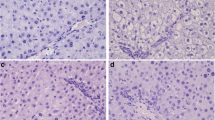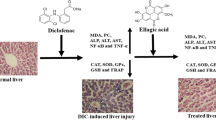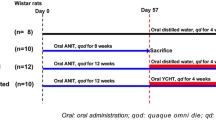Abstract
Ellagic acid (EA) is a natural polyphenolic compound. Although, modulator effects of EA on copper (Cu) and zinc (Zn) levels in some liver diseases have been reported in experimental animals, its effects in obstructive jaundice (OJ) has not been clarified. We aimed to evaluate potential effects of EA on Cu and Zn levels in liver and serum of cholestatic rats. Forty Wistar albino rats were equally divided into four groups. First group was used as controls. Second group received EA (60 mg−1 kg−1 day−1) for 8 days. Third was OJ group, and fourth group was OJ plus EA group. After 8 days, blood and liver samples were obtained. Higher serum and liver Cu and lower serum and liver Zn levels were found in OJ group (p < 0.05) compared with other groups. However, these differences reached to significant levels for Cu in serum and for Zn in lever. Higher serum copper levels were decreased, and lower liver Zn levels were increased by EA treatment in cholestatic rats (p < 0.05). Also, higher Cu/Zn ratio in OJ group was decreased by EA treatment both in liver (p < 0.05) and in serum (p < 0.05). Significantly higher serum bilirubin, alkaline phosphatase, alanine aminotransferase, and aspartate aminotransferase values were found in OJ and OJ + EA groups compared with the control and EA groups (p < 0.05). In conclusion, result of the current study indicated that ellagic acid has modulator effects on Cu and Zn levels in liver and serum of cholestatic rats.


Similar content being viewed by others
Abbreviations
- ALP:
-
Alkaline phosphatase
- ALT:
-
Alanine aminotransferase
- AST:
-
Aspartate aminotransferase
- Cu:
-
Copper
- EA:
-
Ellagic acid
- OJ:
-
Obstructive jaundice
- TB:
-
Total bilirubin
- Zn:
-
Zinc
References
Celebi F, Yilmaz I, Aksoy H, Gumus M, Taysi S, Oren D (2004) Dehydroepiandrosterone prevents oxidative injury in obstructive jaundice in rats. J Int Med Res 32:400–405
Takaoka M, Kubota Y, Tsuji K, Yamamoto S, Ogura M, Yanagitani K, Shimatani M, Shibatani N, Inoue K (2001) Human neutrophil functions in obstructive jaundice. Hepatogastroenterology 48:71–75
Liu TZ, Lee KT, Chern CL, Cheng JT, Stern A, Tsai LY (2001) Free radical-triggered hepatic injury of experimental obstructive jaundice of rats involves overproduction of proinflammatory cytokines and enhanced activation of nuclear factor kappa B. Ann Clin Lab Sci 31:383–390
Naziroglu M, Karaoğlu A, Aksoy AO (2004) Selenium and high dose vitamin E administration protects cisplatin-induced oxidative damage to renal, liver and lens tissues in rats. Toxicology 195:221–230
Iraz M, Ozerol E, Gulec M, Tasdemir S, Idiz N, Fadillioglu E, Naziroglu M, Akyol O (2006) Protective effect of caffeic acid phenethyl ester (CAPE) administration on cisplatin-induced oxidative damage to liver in rat. Cell Biochem Funct 24:357–361
Rodriguez-Moreno F, Gonz Lez-Reimers E, Santolaria-Fernandez F, Galindo-Martin L, Hernandez-Torres O, Batista-Lopez N, Molina-Perez M (1997) Zinc, copper, manganese, and iron in chronic alcoholic liver disease. Alcohol 14:394–394
Maret W (2005) Zinc coordination environments in proteins determine zinc functions. J Trace Elem Med Biol 19:7–12
Ozkaya MO, Nazıroğlu M, Barak C, Berkkanoglu M (2010). Effects of Multivitamin/Mineral Supplementation on Trace Element Levels in Serum and Follicular Fluid of Women Undergoing in Vitro Fertilization (IVF). Biol Trace Elem Res (in press) doi: 10.1007/s12011-010-8637-x.
Onal S, Nazıroğlu M, Colak M, Bulut V, Flores-Arce MF (2010). Effects of different medical treatments on serum copper, selenium and zinc levels in patients with rheumatoid arthritis. Biol Trace Elem Res (in press) doi: 10.1007/s12011-010-8826-7.
Zalewski PD, Truong-Tran AQ, Grosser D, Jayaram L, Murgia C, Ruffin RE (2005) Zinc metabolism in airway epithelium and airway inflammation: basic mechanisms and clinical targets. A review. Pharmacol Ther 105:127i–149i
Stamoulis I, Kouraklis G, Theocharis S (2007) Zinc and the liver: an active interaction. Dig Dis Sci 52:1595–1612
Kovacic P, Somanathan R (2008) Unifying Mechanism for Eye Toxicity: Electron Transfer, Reactive Oxygen Species, Antioxidant Benefits, Cell Signaling and Cell Membranes. Cell Membr Free Radic Res 2:56–69
Song M, Song Z, Barve S, Zhang J (2008) Tetrathiomolybdate protects against bile duct ligation-induced cholestatic liver injury and fibrosis. J Pharmacol Exp Ther 325:409–416
Ebara M, Fukuda H, Hatano R, Yoshikawa M, Sugiura N, Saisho H, Kondo F, Yukawa M (2003) Metal contents in the liver of patients with chronic liver disease caused by hepatitis C virus. Reference to hepatocellular carcinoma. Oncology 65:323–330
Devipriya N, Sudheer AR, Vishwanathan P, Menon VP (2008) Modulatory potential of Ellagic Acid, a natural plant polyphenol on altered lipid profile and lipid peroxidation status during alcohol-induced toxicity: a pathohistological study. J Biochem Mol Toxicol 22:101–112
Devipriya N, Sudheer AR, Menon VP (2007) Dose-response effect of ellagic acid on circulatory antioxidants and lipids during alcohol-induced toxicity in experimental rats. Fund Clin Pharmacol 21:621–630
Bayliss EA, Hambidge KM, Sokol RJ, Stewart B, Lilly JR (1995) Hepatic concentrations of zinc, copper and manganese in infants with extrahepatic biliary atresia. J Trace Elements Med Biol 9:40–43
Suzuki K, Oyama R, Hayashi E, Arakawa Y (1996) Liver diseases and essential trace elements. Nippon Rinsho 54:85–92
Sırmalı M, Uz E, Sırmalı R, Kılbas A, Yılmaz HR, Altuntas I, Nazıroglu M, Delibas N, Vural H (2007) Protective effects of erdosteine and vitamins C and E combination on ischemia–reperfusion-induced lung oxidative stress and plasma copper and zinc levels in a rat hind limb model. Biol Trace Elem Res 118:43–52
Selvaraj A, Balamurugan K, Yepiskoposyan H, Zhou H, Egli D, Georgiev O, Thiele DJ, Schaffner W (2005) Metal-responsive transcription factor (MTF-1) handles both extremes, copper load and copper starvation, by activating different genes. Genes Dev 19:891–896
Polavarapu R, Spitz DR, Sim JE, Follansbee MH, Oberley LW, Rahemtulla A, Nanji AA (1998) Increased lipid peroxidation and impaired antioxidant enzyme function is associated with pathological liver injury in experimental alcoholic liver disease in rats fed diets high in corn oil and fish oil. Hepatology 27:1317–1323
Fotakis G, Timbrell JA (2006) Role of trace elements in cadmium chloride uptake in hepatoma cell lines, Toxicol. Lett 164(2):97–103
Joshi D, Mittal D, Nirala SK, Bhadauria M, Shrivastava S, Shukla S (2010) Role of micronutrients against dimethylmercury intoxication in male rats. Environ Toxicol Pharmacol 29:97–103
Poo JL, Rosas-Romero R, Montemayor AC, Isoard F, Uribe M (2003) Diagnostic value of the copper/zinc ratio in hepatocellular carcinoma:a case control study. J Gastroenterol 38:45–51
Boz A, Evliyaoglu O, Yildirim M, Erkan N, Karaca B (2005) The Value of serum zinc, copper, ceruloplasmin levels in patients with gastrointestinal tract cancers. Turk J Gastroenterol 16:81–84
Gupta SK, Singh SP, Shukla VK (2005) Copper, zinc, and Cu/Zn ratio in carcinoma of the gallbladder. J Surg Oncol 91:204–208
Fabris C, Farini R, Del Favero G, Gurrieri G, Piccoli A, Sturniolo GC, Panucci A, Naccarato R (1985) Copper, zinc and copper/zinc ratio in chronic pancreatitis and pancreatic cancer. Clin Biochem 18:373–375
Lee J, Koo N, Min DB (2004) Reactive oxygen species, aging, and antioxidative nutraceuticals. Compr Rev Food Sci Food Saf 3:21–33
Ahmed S, Rahman A, Saleem M, Athar M, Sultana S (1999) Ellagic acid ameliorates nickel induced biochemical alterations: diminution of oxidative stress. Hum Exp Toxicol 18:691–698
Thresiamma KC, Kuttan R (1996) Inhibition of liver fibrosis by ellagic acid. Indian J Physiol Pharmacol 40:363–366
Author information
Authors and Affiliations
Corresponding author
Rights and permissions
About this article
Cite this article
Gümüş, M., Yüksel, H., Evliyaoğlu, O. et al. Effects of Ellagic Acid on Copper, Zinc, and Biochemical Values in Serum and Liver of Experimental Cholestatic Rats. Biol Trace Elem Res 143, 386–393 (2011). https://doi.org/10.1007/s12011-010-8863-2
Received:
Accepted:
Published:
Issue Date:
DOI: https://doi.org/10.1007/s12011-010-8863-2




